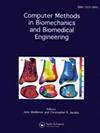Finite element analysis and surrogate-optimized design of a nature-inspired auxetic stent.
IF 1.7
4区 医学
Q3 COMPUTER SCIENCE, INTERDISCIPLINARY APPLICATIONS
Computer Methods in Biomechanics and Biomedical Engineering
Pub Date : 2024-09-10
DOI:10.1080/10255842.2024.2399018
引用次数: 0
Abstract
Prior studies have revealed that the structural design of stents is critical to reducing some of the alarming post-operative complications associated with stent-related intervention. However, the technical search for stents that guarantee robustness against stent-induced post-intervention complications remains an open problem. Along this objective, this study investigates a re-entrant auxetic stent's structural response and performance optimizations. In pursuit of the goal, a nonlinear finite element analysis (FEA) is employed to uncover metrics characterizing the auxetic stent's mechanical behavior. Subsequently, the non-dominated sorting genetic algorithm (NSGA-II) is implemented to simultaneously minimize the stent's von Mises stress and the elastic radial recoil (ERR). Results from the FEA revealed a tight connection between the stent's response and the features of the base auxetic building block (the rib length, strut width, and the re-entrant angle). It is observed that the auxetic stent exhibits a much lower ERR. Besides, larger values of its rib length and re-entrant angle are noticed to favor smaller von Mises stress. The Pareto-optimal front from the NSGA-II-based optimization scheme revealed a sharp trade-off in the simultaneous minimization of the von Mises stress and the ERR. Moreover, an optimal combination of the auxetic unit cell's geometric parameters is found to yield a much lower maximum von Mises stress of ≈403 MPa and ERR of ≈0.4%.受自然启发的辅助支架的有限元分析和代用优化设计。
先前的研究表明,支架的结构设计对于减少与支架相关的介入治疗引起的一些令人担忧的术后并发症至关重要。然而,如何从技术上寻求支架,以确保其坚固耐用,防止支架引发介入术后并发症,仍是一个有待解决的问题。根据这一目标,本研究对再入式辅助支架的结构响应和性能优化进行了研究。为了实现这一目标,我们采用了非线性有限元分析(FEA)来揭示辅助支架机械行为的特征指标。随后,采用非支配排序遗传算法(NSGA-II)同时最小化支架的冯米塞斯应力和弹性径向反冲(ERR)。有限元分析的结果表明,支架的响应与基础辅助构件的特征(肋骨长度、支柱宽度和再入角等)密切相关。可以看出,辅助支架的等效误差要小得多。此外,肋长和再入角值越大,von Mises 应力越小。基于 NSGA-II 的优化方案得出的帕累托最优前沿显示,在同时最小化 von Mises 应力和 ERR 的过程中,存在着急剧的权衡。此外,还发现辅助单元几何参数的最佳组合可产生更低的最大 von Mises 应力(≈403 兆帕)和ERR(≈0.4%)。
本文章由计算机程序翻译,如有差异,请以英文原文为准。
求助全文
约1分钟内获得全文
求助全文
来源期刊
CiteScore
4.10
自引率
6.20%
发文量
179
审稿时长
4-8 weeks
期刊介绍:
The primary aims of Computer Methods in Biomechanics and Biomedical Engineering are to provide a means of communicating the advances being made in the areas of biomechanics and biomedical engineering and to stimulate interest in the continually emerging computer based technologies which are being applied in these multidisciplinary subjects. Computer Methods in Biomechanics and Biomedical Engineering will also provide a focus for the importance of integrating the disciplines of engineering with medical technology and clinical expertise. Such integration will have a major impact on health care in the future.

 求助内容:
求助内容: 应助结果提醒方式:
应助结果提醒方式:


